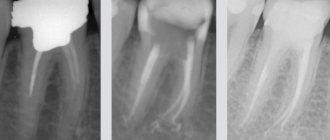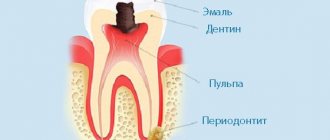- Why a temporary filling is placed: types of material
- Why does a tooth with a temporary filling hurt: the main reasons
- Standard activities after installation of the material
- Temporary filling hurts when pressed: how to cope with the disease
Many patients complain to dentists that their tooth hurts under a temporary filling. For the first 2-3 days, a slight aching pain is considered normal and does not cause cause for concern or panic. It is associated with the active influence of drugs on the nerve endings of the molar or premolar.
If the temporary filling hurts very strongly and for a long time when pressed, it is recommended to make an appointment with a specialist earlier than the specified date. Dentists at the reliable A-Medic clinic will conduct a thorough examination and prescribe a diagnostic examination to find out what exactly is causing the pain. All people are scared that they have had a temporary filling installed and their tooth hurts, but most often there is no reason to worry.
Why a temporary filling is placed: types of material
Non-permanent filling is a mandatory measure in the treatment of complicated carious lesions and root canal inflammation. It is required for medicinal treatment of an inflamed molar or premolar. It is entrusted with the protective function of the treated cavity from food ingress. Also, it prevents the medical pad from falling out.
The composition of such material differs significantly from a permanent filling. It can be made from water-insoluble or plastic components. The choice of the most suitable material directly depends on the condition of the molar or premolar and the purpose of the installation. Among the most common materials are:
- sympath. It can be of different shades - white (for filling non-pulp teeth) or light pink. The mass does not provoke irritation and other allergic reactions;
- dentin paste. It reliably protects the tooth from staining with amalgams and is characterized by water-repellent properties. The paste hardens in 100-120 minutes;
- zinc polyacrylate cement. It is characterized by good biocompatibility with tissues and high strength. The material is used for fixing prostheses (crowns) or filling (both permanent and baby teeth);
- Vinoxol. It is characterized by reliability and durability, capable of maintaining integrity for up to 4-5 months. The drug has antiseptic properties, which allows you to disinfect the tooth cavity. It hardens in 3-4 hours.
There are situations when the carious lesion did not have time to reach the nerve. In such cases, the molar or premolar is not depulped, but temporary material is installed. This is necessary for diagnosis to see whether the tooth will become sensitive or not. With the help of these measures, it is possible to completely preserve a molar or premolar (without removing the nerve) if the patient does not experience pain. If a pronounced reaction occurs (if the temporary filling hurts), the dentist will remove the nerve after placing a filling with arsenic.
Often, non-permanent filling is resorted to during prosthetics. This allows you to protect the molar or premolar from pathogenic microorganisms. The wearing period is individual and directly depends on the type of material and the reason why filling was required. It is installed by the attending dentist. On average, after 7-10, specialists replace it with a permanent filling. Sometimes, after applying a temporary filling, a tooth hurts; let’s figure out what could cause this phenomenon.
Pulping the tooth before prosthetics
Depulping a tooth before installing a crown: indications
What happens to a depulped tooth?
Is it possible to place a crown without depulpation?
In fact, it would be correct to say “tooth depulpation”, because before prosthetic treatment of a tooth, the dentist processes it and removes the pulp according to indications. Dental depulpation is the removal of the dental nerve. The procedure is performed during the treatment of pulpitis and periodontitis, as well as before prosthetics. However, in the latter case, depulpation is carried out only when indicated; sometimes doctors install a crown on a living tooth. We will tell you in the article what this depends on.
Why does a tooth with a temporary filling hurt: the main reasons
Often, patients with a temporary filling have a toothache when pressed. In some cases, such a reaction is considered normal. The attending physician will be able to answer for sure why a tooth hurts after a temporary filling after examining the oral cavity and conducting a diagnostic examination. Let's take a closer look at the main reasons for the appearance of pronounced discomfort sensations:
- Impact of the drug. If a tooth hurts with a temporary filling and medication, then most often the source of discomfort is its effect on the tissue. You should contact a specialist if the pain is pronounced and reduces the quality of life.
- Unfinished therapy. Often, after the pain has subsided, a person decides to stop therapy and does not come to an appointment to replace it with a permanent material. Temporary material is not intended to be worn for several years, so sooner or later it will fall out. It is recommended to replace at the appointed time.
- Allergic reaction to cementitious agent. If a tooth with a temporary filling aches and hurts a lot, the reason may lie in an allergic reaction. In such a situation, it would be more advisable to replace it with another cementing agent (depending on the period of wear).
- Lack of material. There is a high probability that it fell out while drinking or eating food, so external factors (irritants) come into direct contact with the soft tissues. An infection could have entered the tooth cavity, causing an inflammatory reaction.
- Prolonged wearing of the cementing agent (longer than the prescribed period). The material is quite fragile; when worn for a long time, it begins to lose its tightness, allowing pathogenic microorganisms (bacteria) to enter the cavity of the molar or premolar.
The biggest cause for concern is discomfort after installation of permanent material. This is an alarming signal that may indicate incorrect installation, untreated pathology, or emerging complications. In this situation, you need to make an appointment with a specialist to determine the main source of pain.
Should I see a doctor if I have pain after root canal cleaning?
Root canal cleaning is a surgical procedure that is performed when infection occurs and inflammation develops. Most often it is performed for pulpitis or periodontitis. This affects the soft tissues of the oral cavity. It should be borne in mind that in this case, already inflamed tissues are treated, and after cleaning, the inflammation persists for several days.
Therefore, a slight aching pain after therapy is normal and is not considered a cause for concern. At night, the pain often intensifies.
After a couple of days, the healing process enters an active phase, the pain slowly and gradually decreases, although pain and discomfort may persist for several weeks. They can be reduced or eliminated through anesthetic medications and rinses.
The pain syndrome can persist for a long time if the patient delays visiting the dentist, as a result of which the inflammation has become extensive and severe. Therefore, it is so important to regularly visit a specialist, undergo preventive examinations and visit a doctor at the first signs of illness. The sooner the problem is detected, the less complex and painful the therapy and rehabilitation will be.
Standard activities after installation of the material
Do not drink or eat until the material has completely hardened, as it may crack or fall out completely. Also, food can get into the cavity of a molar or premolar. After a non-permanent filling, it is not recommended to eat soft food for the first 2-3 hours, and hard food for 10-12 hours. This will avoid a number of negative consequences. When chewing solid food in the future, you should use less of the side on which the filling was performed.
While wearing the material, hygiene rules must not be neglected. You should brush your teeth twice a day, and after eating, rinse your mouth with antiseptic solutions and floss. If the temporary material is installed for several months, it is recommended to use a brush with softer bristles during this period. To avoid possible complications, the material is removed on a strictly designated day.
Causes of pain
After pulpitis, a tooth hurts for several reasons - damage to the tissues surrounding the tooth root (periodontal) or an inflammatory process.
Tissue damage can be caused by the following circumstances:
- formation of a wound surface during removal of the neurovascular bundle of a tooth;
- treatment of root canals with antiseptic agents if the antiseptic leaves the canal.
Can a tooth hurt after pulpitis due to the dentist’s dishonest work? The inflammatory process can occur due to poor quality work by the doctor. Signs of poor treatment of pulpitis on an x-ray are:
- incomplete filling of root canals, when there is still free space left to the apex;
- excessive filling of root canals, when the filling material extends beyond the apex of the root canal;
- extra holes in the root canals.
Temporary filling hurts when pressed: how to cope with the disease?
People often ask the question: “if you have a temporary filling installed and your tooth hurts, what should you do?” When a tooth hurts under a temporary filling, this is a normal condition, do not panic. If the dentist said that there is no cause for concern, you should be patient and wait out the unpleasant symptom. When a temporary filling causes severe pain in a tooth, and you run out of strength to endure the pain, you can use the following recommendations:
- rinse your mouth with antiseptic and soothing solutions. You can prepare them yourself at home from natural ingredients. For example, chamomile and sage are poured with boiling water and the resulting product is used to rinse the mouth;
- do not allow food and drinks (mainly hot or cold) to come into contact with the treated tooth;
- take a painkiller (analgesic). “Nise” and “Ketorol” give good results;
- make lotions with valerian tincture. A moistened cotton swab of valerian is applied to the painful area, the gum near the tooth. This will temporarily relieve the irritation.
If a tooth hurts after installing a temporary filling and swelling or redness of the soft tissue appears, this may indicate the presence of an inflammatory process or the appearance of pus. In such a situation, you should re-make an appointment with a dentist-therapist. The A-Medic clinic employs qualified specialists with extensive experience. To make an appointment, just fill out the standard form on the official website of the clinic (indicating your full name and contact number). Prices are affordable, and consultation with a dentist is completely free.
In what cases is pain after canal cleaning not normal and what to do?
If the pain does not subside within several days and does not decrease, this may indicate complications or that the treatment was carried out incorrectly.
When pain is a symptom of pathology:
- if the pain does not decrease within several days;
- if the pain increases;
- for acute and throbbing pain;
- swelling and severe swelling of the gums;
- increased body temperature;
- general deterioration of health.
In these cases, you should immediately consult a doctor; there are complications after treatment.
Abnormal pain can result from a number of factors:
- a mistake made during treatment;
- poor-quality cleaning of the canal - repeated opening and cleaning is required;
- a fragment of a tooth or instrument remains in the canal cavity;
- individual intolerance of the body, allergy to components in the filling material or medications;
- poor-quality placement of the filling or the filling material protrudes above the surface of the tooth;
- inflammation of periodontal tissue – the infection has spread from the pulp to the gum;
- perforation of the canal walls due to accidental movement of the instrument;
- during the treatment the tooth root was touched and damaged;
- penetration of infection and development of re-inflammation.
In all these cases, inspection, diagnosis, identification of the problem and its prompt elimination are required.
If you ignore the symptoms for a long time and postpone a visit to the dentist, this can increase the inflammatory process and ultimately lead to the need for tooth extraction. Moreover, an infection that is not eliminated in time can spread to neighboring teeth, causing inflammation and the development of the disease.
In no case should you try to fix the problem yourself, much less apply heat compresses to the affected area, take hot food or alcohol - this stimulates the development of inflammatory processes and suppuration. The only solution to the problem is an immediate visit to the clinic.
What determines pain and discomfort during the rehabilitation period?
A few hours after the operation, the effect of the anesthetic drugs wears off and the patient may feel discomfort and pain in different areas: in the jaw and the joints closest to it, in the throat, in the frontal and temporal parts of the head.
The degree of pain varies for each patient, because... depends on several factors:
- number of implants installed (replacement of 1 tooth, full implantation according to all-on-4/all-on-6 protocols), their size (regular or long pins for zygomatic implantation);
- Everyone's pain threshold level is different;
- Implantation may be accompanied by additional procedures, for example, sinus lift.
Note
. In the vast majority of cases, pain after implantation goes away 5-14 days after surgery.











